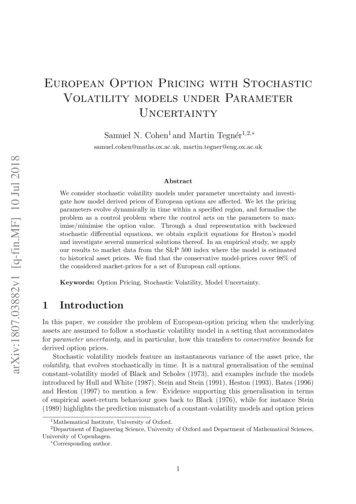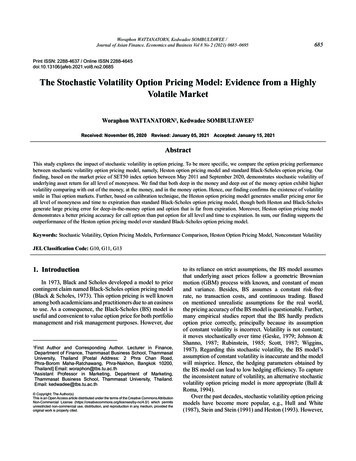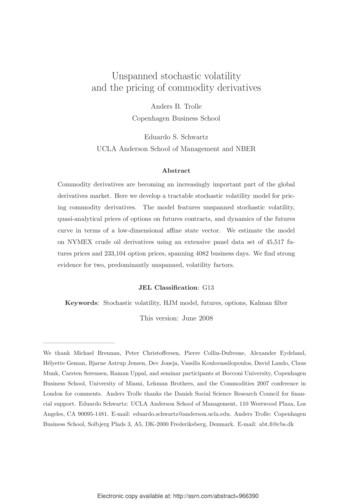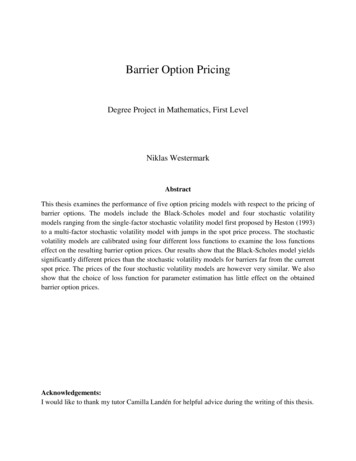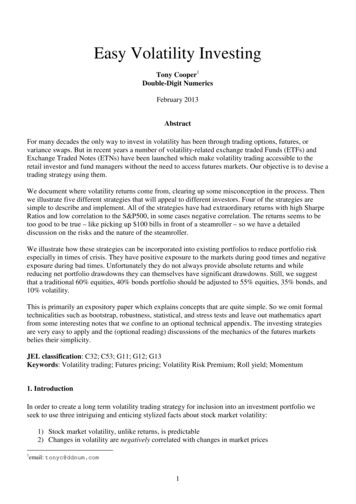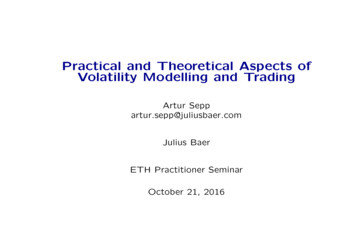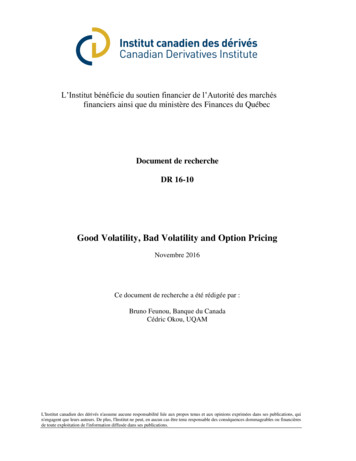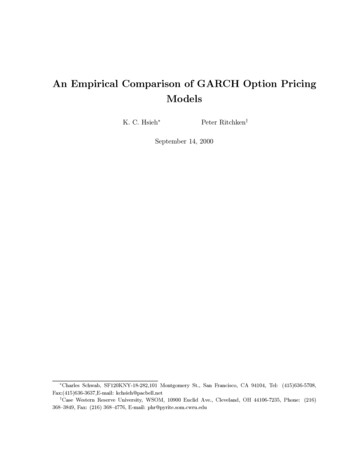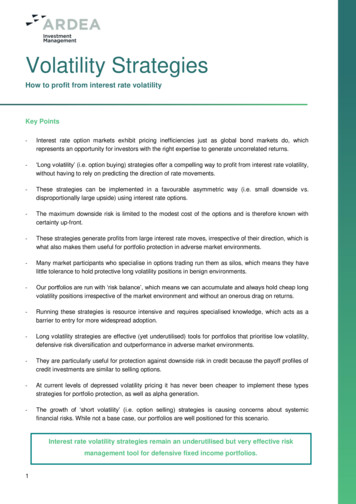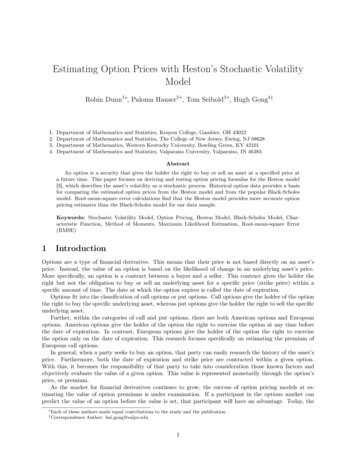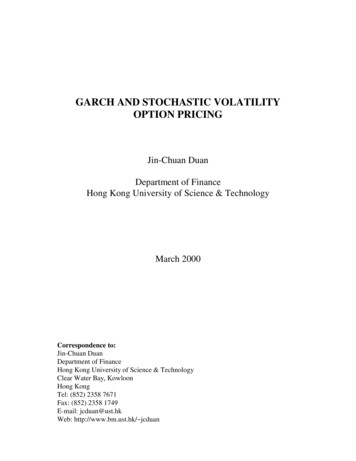
Transcription
GARCH AND STOCHASTIC VOLATILITYOPTION PRICINGJin-Chuan DuanDepartment of FinanceHong Kong University of Science & TechnologyMarch 2000Correspondence to:Jin-Chuan DuanDepartment of FinanceHong Kong University of Science & TechnologyClear Water Bay, KowloonHong KongTel: (852) 2358 7671Fax: (852) 2358 1749E-mail: jcduan@ust.hkWeb: http://www.bm.ust.hk/ jcduan
Outline1.Black-Scholes model 2.The GARCH option pricing model 3.Skewness and kurtosisRisk premium and stationary volatilityUtilize volatility smile in applications 7.Put-call parity regressionFTSE 100 index optionsThe general properties of the GARCH option pricingmodel 6.Monte Carlo simulationsMarkov chain approximationLattice constructionAnalytical approximationNeural network approximationTackling volatility smile using GARCH 5.Data generating vs. risk-neutral price dynamicsForeign currency option pricingNumerical methods for the GARCH option pricingmodel 4.Implied volatility vs. historical volatilityVolatility smilePricing exotic optionsGARCH delta and vega hedgingRisk-neutral probabilitiesOption pricing under stochastic volatility Diffusion limit of the GARCH modelDiffusion limit of the GARCH option pricing modelNumerical performanceGARCH OPMJC Duan (3/2000)2
1. Black-Scholes Model (1973) Asset price processσ2d ln( St ) (r λσ )dt σdWt2 Risk-neutralized asset price processσ2d ln( St ) (r )dt σdWt*2 Pricing formulaFor a European call option payoff at time T,Max ( ST K ,0)its time-0 value is by the closed-form solutionC ( S0 ; K , T , r , σ ) S0 N (d ) Ke rT N (d σ T )whereS0σ2ln (r )TK2d σ T Implied VolatilityFind σ * ( Ki , Tj ) to solveC mkt ( Ki , T j ) C ( S0 ; Ki , T j , r , σ * ( Ki , T j ))GARCH OPMJC Duan (3/2000)3
Implied volatility vs. historical volatilityIf the Black-Scholes model works well, the impliedvolatility should be roughly the same as the historicalvolatility. (March 11, 1998, South China Morning Post;Historical volatility (250 days) equals 46%.)GARCH OPMJC Duan (3/2000)4
Volatility SmileIf the Black-Scholes model works well, impliedvolatility σ * ( Ki , Tj ) should be independent of Ki and Tj. Inreality, σ * ( Ki , Tj ) varies systematically with Ki and Tj.Example 1: FTSE 100 index optionsImpliedVolatility0.18Implied Volatilities of FTSE 100 Index Calls(Euro style) on March 31, .130.1229753025307531253175Strike PriceGARCH OPMJC Duan (3/2000)5322532753325
ImpliedVolatility0.18Implied Volatilities of FTSE 100 Index Calls(Euro style) on April 7, .130.1230253075312531753225327533253375Strike PriceExample 2: Hang Seng index optionsImpliedVolatility2890Implied Volatilities of HS Index Callson Feb 28, 19970.25600.240.230.220.210.200.190.180.17GARCH OPMJC Duan (3/2000)6142001400013800Strike Price136001340013200130001280012600124000.16
ImpliedVolatility2183Implied Volatilities of HS Index Callson March 7, 0013800Strike Price136001340013200130001280012600124000.162. GARCH Option Pricing Model (Duan, 1995) Asset price dynamics modeled by a non-linear asymmetricGARCH (NGARCH)-in-mean processSt 1σ t2 1ln r λσ t 1 σ t 1ε t 1St2σ t2 1 β 0 β 1σ t2 β 2σ t2 (ε t θ )2Pε t 1 Ft N (0,1)GARCH OPMJC Duan (3/2000)7
Locally risk-neutralized asset price processSt 1σ t2 1ln r σ t 1ε *t 12Stσ 2t 1 β 0 β 1σ t2 β 2σ t2 (ε *t θ λ )2Qε *t 1 Ft N (0,1)This impliesT1 T ST S0 exp Tr σ 2s σ s ε *s 2 s 1 s 1 Option pricingFor a European call option with a payoff at time T:Max ( ST K ,0)its time-0 value isC ( S0 , σ1; K , T , r , β0 , β1, β2 ,θ λ ) e rT E0Q { Max ( ST K ,0)} Forex option pricing under GARCHRisk-neutralized exchange rate process under BlackScholesσ2d ln(et ) (r rf )dt σdWt*2GARCH OPMJC Duan (3/2000)8
Garman and Kohlhagen (1983) formulaC (e0 ; K , T , r , r f , σ ) e0e rf TN (d ) Ke rT N (d 0 σ T )wheree0σ2ln (r r f )TK2d σ TLocally risk-neutralized exchange rate process underGARCHet 1σ t2 1ln r rf σ t 1εt* 1et2σ t2 1 β0 β1σ t2 β2σ t2 (εt* θ λ ) 2Q*εt 1 Ft N (0,1)Forex option price under GARCHC (e0 , σ1; K , T , r , r f , β0 , β1, β2 ,θ λ ) e rT E0Q { Max (eT K ,0)}Note:1. For quanto option pricing under GARCH, please see Duanand Wei (1999).2. An arbitrage-free proof of the GARCH option pricing modelcan be found in Kallsen and Taqqu (1998). It is accomplishedby using the geometric Brownian motion to connect thediscrete-time GARCH model.GARCH OPMJC Duan (3/2000)9
3. Numerical methods Monte Carlo simulations1) Standard Monte Carlo simulationSt (i ) S0 exp[(r δ )t ]Zt (i )Zt (i ) Zt 1(i ) exp[ 0.5σ t2 σ t ε t (i )]2) Empirical martingale simulation (EMS) (Duan &Simonato, 1998)St (i ) S0 exp[(r δ )t ]Zt (i )Zt (i ) Zt 1(i ) exp[ 0.5σ t2 σ t ε t (i )]1 n2 Zt 1(i ) exp[ 0.5σ t σ t ε t (i )]n i 1Thus,1 n exp[ (r δ )t ]St (i ) S0n i 1GARCH OPMJC Duan (3/2000)10
Worksheet: Standard Monte Carlo Simulation for valuing call option under GARCHCurrent stock price Initial conditional s.d. (annualized) Interest rate (annualized) Number of sample paths Maturity (days) 2GARCH parameters:Beta0 Beta1 Beta2 Theta Lambda 510.20.0510Strike price (X) 501E-050.80.10.50.3Stationary standard deviations (annualized) implied by the GARCH parameters:Data generating 0.2206Risk neutral 0.3184std. 2550.87551.169std. 0.2220.1910.2610.2000.191S(2) 050.1510.15151.3711.371Discounted average (or Monte Carlo price) GARCH OPMJC Duan (3/2000)111.0079
Worksheet: Empirical Martingale Simulation for valuing call option under GARCHCurrent stock price Initial conditional s.d. (annualized) Interest rate (annualized) Number of sample paths Maturity (days) 2GARCH parameters:Beta0 Beta1 Beta2 Theta Lambda 510.20.0510Strike price (X) 501E-050.80.10.50.3Stationary standard deviations (annualized) implied by the GARCH parameters:Data generating 0.2206Risk neutral 0.3184std. 20249.92550.87551.16950.866std. 0.1900.1900.1900.2220.1910.2610.2000.191Discounted average (or Monte Carlo price) GARCH OPMJC Duan 51.24348.91850.15151.37150.900S*(2) 0050.2640.26451.4861.4861.1109
A comparison: Black-Scholes option pricing model (batch size 1000; S0 100, r 0.1, δ 0, σ 0.2, T 1 month)At-the-money European call option price estimate2.762.722.682.64CrudeBatc h EMS2.601112131415161718191Standard deviation of the price estimate(at-the-money European call option; two hundred repetitions)0.12CrudeBatch EMS0.080.040.001GARCH OPMJC Duan (3/2000)11213141511361718191
Markov chain approximation (Duan & Simonato, 1999)Discretize the underlying asset prices1pt ( r h* )t ln( St )2qt 1 ln( ht 1)whereh* β01 β1 β 2 [1 (θ λ ) 2 ]Example: m 3, n 3GARCH OPMJC Duan (3/2000)(p(1), q(1))(p(1), q(1))(p(2), q(1))(p(2), q(1))(p(3), q(1))(p(3), q(1))(p(1), q(2))(p(1), q(2))(p(2), q(2))(p(2), q(2))(p(3), q(2))(p(3), q(2))(p(1), q(3))(p(1), q(3))(p(2), q(3))(p(2), q(3))(p(3), q(3))(p(3), q(3))14
Transition probability matrix; ,1) π (1,1;2 ,1) π (1,11 π (2,11; ,1) π (2 ,1;2 ,1) Π "" ; ,1) π (m,1;2 ,1) π (m,11 ""! π (1,1; m,1) π (1,11; ,2 )! π (2 ,1; m,1) π (2,11; ,2 )#""! π (m,1; m,1) π (m,11; ,2 )#""! π (1,1; m, n ) ! π (2,1; m, n ) #" ! π (1,2; m, n ) #"SinceS1ln t 1 r ht 1 ht 1ε t 1St2ht 2 β 0 β1ht 1 β 2 ht 1 (ε t 1 θ λ ) 2qt 2 is a deterministic function of qt 1, pt 1, pt;that is, qt 2 Φ( qt 1, pt 1, pt )π (i , j; k , l ) Pr Q {p C ( k ) p p(i ), q q( j )} if Φ (q( j ), p ( k ), p(i ) ) D(l )t 1tt 1 0otherwiseGARCH OPMJC Duan (3/2000)15
American option prices in the GARCH frameworkPrice vectorP ' [ p(1)p (2) ! p( m) ! p (1)p ( 2) ! p ( m )]American option price computation{V ( P , t ) max g ( P , K , t ),e r ΠV ( P , t 1)}whereV ( P , t ) : American option’s priceK: Strike priceg ( P , K , t ) : European option’s payoff functionV (P ,T ) g(P , K ,T )GARCH OPMJC Duan (3/2000)16
Density of the transition probability matrix (GARCH)m 101, n 11,S0 50, r 0.05, β 0 0.00001, β1 0.8, β 2 0.1, λ 0.2GARCH OPMJC Duan (3/2000)17
Lattice construction (Ritchken & Trevor, 1999)(The following three figures are taken from Ritchken & Trevor, 1999)Note: The maximum and minimum conditional volatilities are given inthe boxes. These figures are multiplied by 105. S0 1000, r 0,λ 0,β0 0.0000065, β1 0.9,β2 0.04,c 0.GARCH OPMJC Duan (3/2000)18
GARCH OPMJC Duan (3/2000)19
GARCH OPMJC Duan (3/2000)20
Analytical approximation (Duan, Gauthier & Simonato,1999)For a European call option payoff at time T,Max ( ST K ,0)its time-0 value is by the approximate closed-form solutionCapp C κ 3 A3 (κ 4 3) A4where C S0 N (d ) Ke rT N (d σ ρT ) d d δS1ln( 0 ) rT σ ρ2K2 Td σ ρT1µρT rT σ ρ22 Tδ σ ρTA3 A4 1 S0σ ρT [(2σ ρT d )n(d ) σ ρ2 N (d )]T3!1 S0σ ρT [(d 2 1 3σ ρT (d σ ρT ))n(d ) σ ρ3 N (d )]T4!Note: µρT and σ ρT are the mean and standard deviation ofSthe cumulative return, i.e., ln T , conditional on timeS00 information; κ 3 and κ 4 are the skewness andkurtosis coefficients of the standardized cumulativereturn, conditional on time-0 information.GARCH OPMJC Duan (3/2000)21
Conditional moments of the cumulative returnFigure 1: Standardized first moment of the cumulative return(GARCH parameter values : β 0 0.00001, β 1 0.7, β 2 0.1, λ θ 1.0, h1 h * )-41.4x 10analytical moment95% confidence intervalmonte Carlo estimate1.31.21.110.90.80.70GARCH OPMJC Duan (3/2000)50100150Number of Days22200250300
Figure 2 : Standardized second moment of the cumulativereturn(GARCH parameter values : β 0 0.00001, β 1 0.7, β 2 0.1, λ θ 1.0, h1 h * )-41.035x 10analytical moment95% confidence intervalmonte Carlo estimate1.031.0251.021.0151.011.00510.9950GARCH OPMJC Duan (3/2000)50100150Number of Days23200250300
Figure 3 : Skewness of the standardized cumulative return(GARCH parameter values : β 0 0.00001, β 1 0.7, β 2 0.1, λ θ 1.0, h1 h * )0.1analytical moment95% confidence intervalmonte Carlo H OPMJC Duan (3/2000)50100150Number of Days24200250300
Figure 4 : Kurtosis of the standardized cumulative return(GARCH parameter values : β 0 0.00001, β 1 0.7, β 2 0.1, λ θ 1.0, h1 h * )7analytical moment95% confidence intervalmonte Carlo estimate6.565.554.543.532.50GARCH OPMJC Duan (3/2000)50100150Number of Days25200250300
Neural network approximation (Hanke, 1997)Euro Call Option under GARCHS X Mat InputsWeights(layer 1)50.55025daysLambda -0.0450.420-0.8000.3720.159-0.0340.5220.623GARCH OPMJC Duan 1-0.309-0.0510.132-0.0700.006-0.0500.024S/XMat (yrs)1.01 221-0.6170.1830.430-0.447
Product 0.468-0.9493.485-3.0341.443-1.464-14.162 .294-3.253-1.5491.970-15.161 61.301tanh(P 50.527-0.9920.840-0.3240.976-0.066SumBias (2nd layer)Option price (before adjustment)Option price (after adjustment)Weights (layer .169-0.0411.0380.022-2.1422 2.17020.02801.3996Note: The above spreadsheet is based on the network constructed byHanke with one hidden layer of 24 neurons. This network islimited to a range of parameters as follows: 0 λ 0.001,0.8 σ1/σ 1.2, 0.7 S/X 1.3, 1/365 τ 30/365, 0.1 σ 0.4,0.5 β1 0.8, 0.1 β2 0.3, 0 r 0.1.GARCH OPMJC Duan (3/2000)27
4. Tackling volatility smile using GARCH Put-call parity regressionC(τ , X ) P(τ , X ) S(τ ) X exp[ τr (τ )] ε (τ , X )This regression can be run for every τ to obtain an intercept andslope. The intercept is S(τ) and the slope is -exp[-τr(τ)],which implies r(τ).Constrained put-call parity regression:Make certain that S(τ) is a non-increasing function of τ.Let τ1 be the smallest maturity and use the followingformulation:C (τ , X ) P(τ , X ) S (τ1 ) a (τ ) X exp[ τr (τ )] ε (τ , X )for τ τ1, τ 2 , ! , τ nwherea(τ ) 0 and a (τ1 ) 0GARCH OPMJC Duan (3/2000)28
FTSE 100 index options (Euro-style) on March 26, 1997MaturityStrike 1.5236.5184126.0210.0183226.5MaturityStrike 48.513.552.5-84.0-43.5InterceptSlopeR 23.8-0.973514204.5-0.961Imp. indexInt. .56%Constrained regressionsImp. indexInt. rate4269.79.16%GARCH OPMJC Duan (3/2000)29
FTSE 100 index optionsA) Calibrate the GARCH option pricing model using themarket prices of traded options in three steps.Step 1: Estimate implied interest rates and index values usingthe put-call parity regression for March 26, 1997Implied interest rates:0.091591 0.060473Implied index 84223.864204.48Step 2: Compute market implied volatilities for calls23Strike Price4125 0.1481924175 0.1385954225 0.1290074275 0.1225654325 0.1159084375 0.1106324425 0.1080714475 0.105673GARCH OPMJC Duan 1465660.1389150.141300
Step 3: Calibrate the GARCH model to minimize the differencebetween the market implied volatility and the modelimplied volatility.Estimated parameter values:β0 0.00000429β1 0.72507034β2 0.07560027θ λ 1.35643575σ1 0.09889376Imp. Risk-Neutral Stationary S.D. 16.12%Implied volatilities derived from the GARCH option pricing modelMaturities235186177268Strike Price4125 0.144981 0.153777 0.153322 0.157534 0.1589914175 0.139704 0.149455 0.150253 0.155788 0.1578674225 0.134155 0.145439 0.147458 0.154096 0.1567584275 0.127844 0.141323 0.144724 0.152474 0.1556854325 0.121891 0.137218 0.142327 0.150752 0.1546274375 0.116696 0.133375 0.140043 0.148963 0.1537054425 0.112325 0.129775 0.137806 0.147262 0.1527664475 0.108033 0.126464 0.135494 0.145531 0.151839Root Mean Squared Error 0.00643679GARCH OPMJC Duan (3/2000)31
Imp. vol.0.20FTSE 100 Index Options onMarch 26, 041254175422542754325437544254475Strike PriceImp. vol. Diff.0.015FTSE 100 Index Options onMarch 26, 4175422542754325-0.005-0.010-0.015Strike PriceGARCH OPMJC Duan (3/2000)32437544254475
B) Out-sample performance on April 2, 1997 (1 week later)Step 1: Estimate implied interest rates and index values usingthe put-call parity regressionImplied interest rates:0.087787 0.055221Implied index 34170.634140.97Step 2: Compute market implied volatilities for calls16Strike Price4075 0.1854014125 0.1714614175 0.1602834225 0.1518144275 0.1427934325 0.1376344375 0.1313144425 16190.1447660.147019Step 3: Calibrate the GARCH model to minimize the differencebetween the market implied volatility and the modelimplied volatility.Pre-set parameter values:β0 0.00000429β1 0.72507034β2 0.07560027θ λ 1.35643575Estimated parameter values:σ1 0.16876672Imp. Risk-Neutral Stationary S.D. 16.12% (unchanged)GARCH OPMJC Duan (3/2000)33
Implied volatilities derived from the GARCH option pricing modelMaturities164479170261Strike Price4075 0.182192 0.170503 0.164460 0.163236 0.1630424125 0.175398 0.165596 0.161139 0.161253 0.1616724175 0.168165 0.160894 0.157961 0.159455 0.1603684225 0.160163 0.156524 0.155017 0.157713 0.1590624275 0.152872 0.152044 0.152459 0.155927 0.1577984325 0.145817 0.147760 0.150011 0.154032 0.1565644375 0.139310 0.142900 0.147438 0.152296 0.1554544425 0.134518 0.138626 0.145090 0.150521 0.154428Root Mean Squared Error 0.00699941Imp. vol.0.20FTSE 100 Index Options onApril 2, 040754125417542254275Strike PriceGARCH OPMJC Duan (3/2000)34432543754425
Imp. vol. Diff.0.015FTSE 100 Index Options onApril 2, ke PriceC) Out-sample performance on April 9, 1997 (2 weeks later)Pre-set parameter values:β0 0.00000429β1 0.72507034β2 0.07560027θ λ 1.35643575Estimated parameter values:σ1 0.15313167Imp. Risk-Neutral Stationary S.D. 16.12% (unchanged)Root Mean Squared Error 0.00697208GARCH OPMJC Duan (3/2000)35
Imp. vol.0.20FTSE 100 Index Options onApril 9, 04125417542254275 4325Strike Price437544254475Imp. vol. Diff.0.015FTSE 100 Index Options onApril 9, 4175422542754325-0.005-0.010-0.015Strike PriceGARCH OPMJC Duan (3/2000)36437544254475
5. The general properties of the GARCH optionpricing model Leptokurtic (fat-tailed) and skewed distributionsUnder the data generating probability1 v24E(ε t ) 3 31 u2θβ 0 β 2Cov(ε t , σ t2 1 ) 1 β 1 β 2 (1 θ 2 )whereu β 22 (3 6θ 2 θ 4 ) 2 β 1β 2 (1 θ 2 ) β 12v β 2 (1 θ 2 ) β 1Under the risk-neutralized probability1 v*2Q *4E (ε t ) 3* 31 u2(θ λ )β 0 β 2Cov Q (ε *t , σ t2 1 ) 1 β 1 β 2 [1 (θ λ )2 ]u* β 22 [3 6(θ λ )2 (θ λ ) 4 ] 2 β 1β 2 [1 (θ λ )2 ] β 12v* β 2 [1 (θ λ )2 ] β 1Note:1. θ is expected to be positive for equity returns2. λ is expected to be positive for equity returnsGARCH OPMJC Duan (3/2000)37
Conclusions:1) Under the data generating probabilityS ln T is negatively skewed if θ 0S0S ln T is leptokurticS02) Under the risk-neutral probabilityS ln T is negatively skewed if θ λ 0S0S ln T is leptokurticS0Prediction for implied volatilities (or option prices):A downward skewed implied volatility smile Risk premium and its effect on stationary (long-run)volatilityPhysical long-run volatility:σ β01 β 1 β 2 (1 θ 2 )Risk-neutralized long-run volatility:β0σ* 1 β 1 β 2 [1 (θ λ )2 ]Note: σ* is greater than σ if λ and θ share the same sign.Prediction for implied volatilities (option prices):Implied volatility should be higher than “realized” or“historical” volatility.GARCH OPMJC Duan (3/2000)38
6. Utilize the volatility smile in applications Pricing exotic optionsOn March 26, 1997, one can price exotic options, say alookback call, using the estimated parameter values:β0β1β2θ λσ1 Worksheet: EMS for valuing a lookback call option under GARCHCurrent stock price Initial conditional s.d. (annualized) Interest rate (annualized) Number of sample paths Maturity (days) 2510.09890.0510GARCH parameters:Beta0 4E-06Beta1 0.7251Beta2 0.0756Theta 1.3564Lambda 0Stationary standard deviations (annualized) implied by the GARCH parameters:Data generating 0.1612Risk neutral 0.1612std. 7-2.0435-0.24280.3091GARCH OPMJC Duan (3/2000)std. -1.4961-1.37600.384539
) Min(S*(t))51.078 50.86151.080 50.93251.198 51.00051.021 51.00051.166 51.00051.523 50.80051.184 51.00050.013 50.01350.627 50.62751.250 51.000Discounted average (or Monte Carlo price) 0.1906Note: P max[S*(2)-min(S*(t);t 0,1,2),0] GARCH delta and vega hedgingStatic call option delta (see Duan, 1995):δt C( St , σ t2 1 ; T , X , r, Φ) St S e r ( T t ) EtQ T χ {ST X} St Call option vega:Λt C( St , σ t2 1; T , X , r, Φ) σ t2 1T ε τ*1 r (T t ) Q Et ST χ {ST X} ( e 1)Gt 1,τ t 1 2 τ t 1 σ τwhere()Gt , k Gt , k 1 β 1 β 2 (ε τ* θ λ )2 and G0 1GARCH OPMJC Duan 00.0000.250
Dynamic call option delta:β 2 (ε τ* θ λ )*δ t δ t 2Λ tStbecause C( St , σ t2 1; T , X , r, Φ) δ t St Λ t σ t2 1 σ t2 1 St δ t Λt St β 2 (ε τ* θ λ ) St δ t 2 Λ tS t Risk-neutral probabilities(PrtQ{ST x} EtQ χ {ST x})The risk-neutral probability can be easily evaluated using theEMS.One can thus use the estimated GARCH parameter values togenerate a risk-neutral probability distribution. This is a betterapproach than other schemes, such as Shimko (1993) andRubinstein (1994), for obtaining the risk-neutral probabilitydistribution.GARCH OPMJC Duan (3/2000)41
7. Option pricing under stochastic volatility Data generating system1Divide [0,T] into nT subintervals of length s . Letnε k , k 1,2, ! be a sequence of i.i.d. standard normal randomvariables.( n)(n) 1 (n)2(n)ln S ks ln S((kn ) 1) s (r λσ ks σ ks ) s σ ksεk s2( n) 2( n) 2[ β1 β 2 (1 θ 2 ) 1]sσ ((kn )21) s σ ks β 0 s σ ks( n) 2[ β 2 (ε k θ ) 2 β 2 (1 θ 2 )] s σ ksNote that if s 1, we have the NGARCH(1,1)-mean model.As n goes to infinity, the approximating model becomes1d ln St (r λσ t σ t2 )dt σ t dW1,t2()dσ t2 β 0 [ β1 β 2 (1 θ 2 ) 1]σ t2 dt 2θβ 2σ t2 dW1,t 2 β 2σ t2 dW2,twhere W1,t and W2,t are two independent standard Brownianmotions.GARCH OPMJC Duan (3/2000)42
Locally risk-neutralized pricing systemDenote the risk-neutralized probability law by Q. Letε k* ε k λ s , for k 1,2,! . They form a sequence of i.i.d.standard normal random variables with respect to Q. Thepricing system becomes1 (n)2(n)( n) *ln S ks) s σ ks ln S((kn ) 1) s (r σ ksεk s2( n) 2( n) 2[ β1 β 2 (1 θ 2 ) 1]sσ ((kn ) 21) s σ ks β 0 s σ ks( n) 2[ β 2 (ε k* θ λ s ) 2 β 2 (1 θ 2 )] s σ ksNote that if s 1, we have the NGARCH(1,1) option pricingmodel.As n goes to infinity, the approximating model becomes1d ln St (r σ t2 )dt σ t dW1*,t2()dσ t2 β 0 [ β1 β 2 (1 θ 2 ) 1 2θβ 2λ ]σ t2 dt 2θβ 2σ t2 dW1*,t 2 β 2σ t2 dW2*,twhere W1*,t and W2*,t are two independent standard Brownianmotions under Q.Note that this is the pricing result directly deduced from theGARCH option pricing theory.GARCH OPMJC Duan (3/2000)43
Numerical performance of the GARCH approximationNote: The following two tables are taken from Ritchken andTrevor (1999), “Pricing Options under GeneralizedGARCH and Stochastic Volatility Processess.”Comparison using Monte Carlo simulationsGARCH OPMJC Duan (3/2000)44
Convergence speed of Ritchken and Trevor’s lattice algorithmGARCH OPMJC Duan (3/2000)45
ReferencesBlack, F. and M. Scholes, 1973, “The Pricing of Options and Corporate Liabilities,”Journal of Political Economy 81, 637-659.Duan, J.-C., 1995, “The GARCH Option Pricing Model,” Mathematical Finance 5,13-32.Duan, J.-C., 1996, “Cracking the Smile,” Risk (December), 55-59.Duan, J.-C. and J.-G. Simonato, 1998, “Empirical Martingale Simulation for AssetPrices,” Management Science 44, 1218-1233.Duan, J.-C. and J.-G. Simonato, 1999, “American Option Pricing under GARCH by aMarkov Chain Approximation,” Journal of Economic Dynamics andControl, forthcoming.Duan, J.-C. and J. Wei, 1999, “Pricing Foreign Currency and Cross-Currency Optionsunder GARCH,” Journal of Derivatives 7, 51-63.Duan, J.-C., G. Gauthier, J.-G. Simonato, 1999, “An Analytical Approximation for theGARCH Option Pricing Model,” Journal of Computational Finance 2, 75116.Garman, M. and S. Kohlhagen, 1983, “Foreign Currency Option Values,” Journal ofInternational Money and Finance 2, 231-253.Hanke, M., 1997, “Neural Network Approximation of Option Pricing Formulas forAnalytically Intractable Option Pricing Models,” Journal of ComputationalIntelligence in Finance 5, 20-27.Kallsen, J. and M. Taqqu, 1998, “Option Pricing in ARCH-Type Models,”Mathematical Finance 8, 13-26.Ritchken, P. and R. Trevor, 1999, “Pricing Option under Generalized GARCH andStochastic Volatility Processes,” Journal of Finance 54, 377-402.Rubinstein, M., 1994, “Implied Binomial Trees,” Journal of Finance 49, 771-818.Shimko, D., 1993, “Bounds of Probability,” Risk (April), 33-37.GARCH OPMJC Duan (3/2000)46
Implied volatility vs. historical volatility Volatility smile 2. The GARCH option pricing model Data generating vs. risk-neutral price dynamics Foreign currency option pricing 3. Numerical methods for the GARCH option pricing model Monte Carlo simulations Markov chain approximation Lattice construction
